Specsavers Optical: ILM Level 2 Workplace Communication Assignment
VerifiedAdded on 2023/06/10
|6
|2634
|253
Homework Assignment
AI Summary
This assignment explores the critical aspects of workplace communication within the context of an ILM Level 2 qualification, specifically addressing the importance of maintaining records of both oral and electronic communication. The document begins by outlining the significance of keeping a record of oral communications, emphasizing the need for accuracy in decision-making, customer relations, and operational efficiency. It highlights how maintaining records aids in recalling conversations, supporting decision-making processes, and ensuring transparency. The solution then describes various methods for maintaining accurate records of electronic and oral communication, including the use of emails, memos, letters, meeting minutes, and short reports. The assignment underscores the importance of these methods for ensuring that no relevant information is missed and that accurate records are available for future reference. The document also includes a mark sheet with assessment criteria for the assignment.
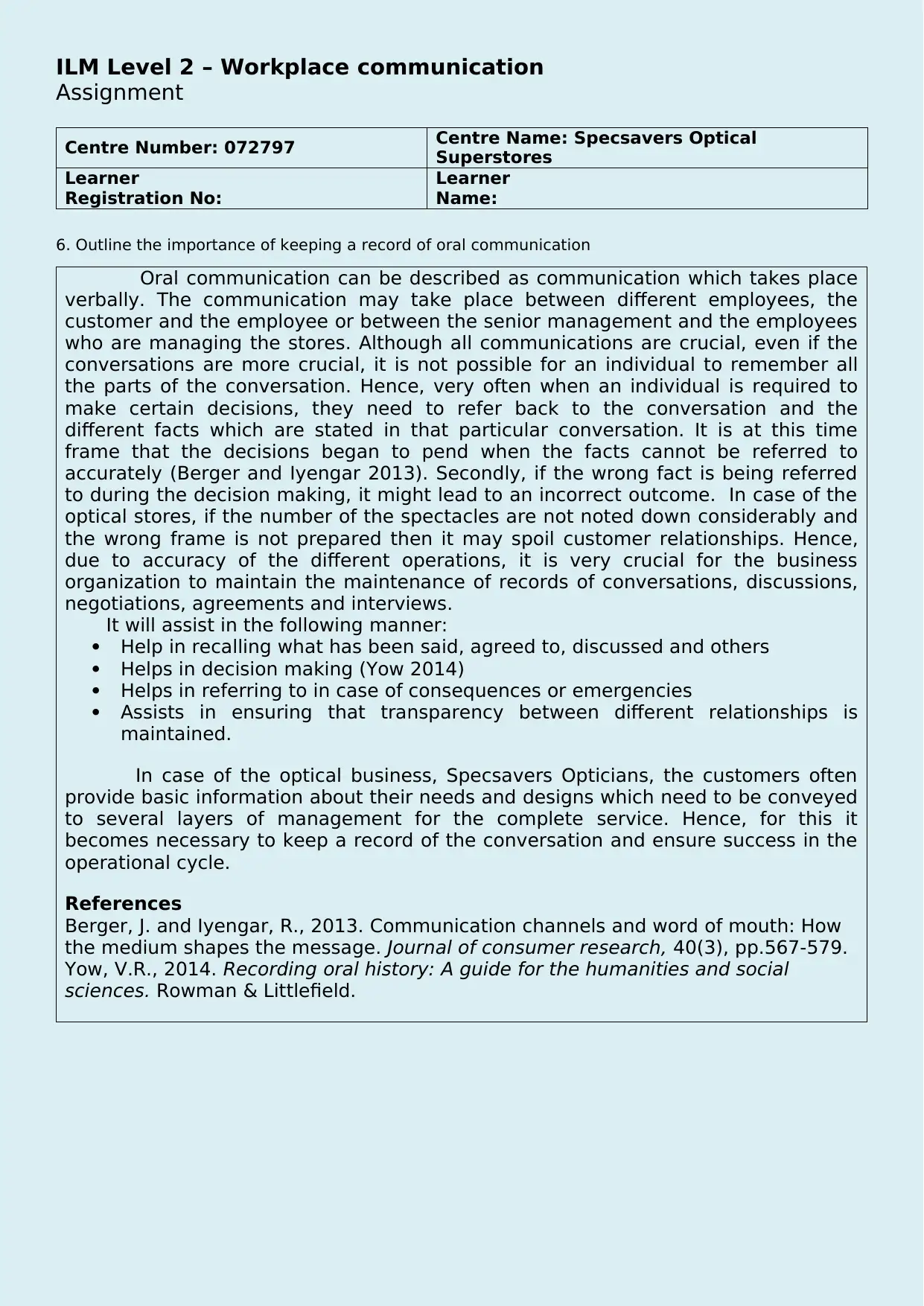
ILM Level 2 – Workplace communication
Assignment
Centre Number: 072797 Centre Name: Specsavers Optical
Superstores
Learner
Registration No:
Learner
Name:
6. Outline the importance of keeping a record of oral communication
Oral communication can be described as communication which takes place
verbally. The communication may take place between different employees, the
customer and the employee or between the senior management and the employees
who are managing the stores. Although all communications are crucial, even if the
conversations are more crucial, it is not possible for an individual to remember all
the parts of the conversation. Hence, very often when an individual is required to
make certain decisions, they need to refer back to the conversation and the
different facts which are stated in that particular conversation. It is at this time
frame that the decisions began to pend when the facts cannot be referred to
accurately (Berger and Iyengar 2013). Secondly, if the wrong fact is being referred
to during the decision making, it might lead to an incorrect outcome. In case of the
optical stores, if the number of the spectacles are not noted down considerably and
the wrong frame is not prepared then it may spoil customer relationships. Hence,
due to accuracy of the different operations, it is very crucial for the business
organization to maintain the maintenance of records of conversations, discussions,
negotiations, agreements and interviews.
It will assist in the following manner:
Help in recalling what has been said, agreed to, discussed and others
Helps in decision making (Yow 2014)
Helps in referring to in case of consequences or emergencies
Assists in ensuring that transparency between different relationships is
maintained.
In case of the optical business, Specsavers Opticians, the customers often
provide basic information about their needs and designs which need to be conveyed
to several layers of management for the complete service. Hence, for this it
becomes necessary to keep a record of the conversation and ensure success in the
operational cycle.
References
Berger, J. and Iyengar, R., 2013. Communication channels and word of mouth: How
the medium shapes the message. Journal of consumer research, 40(3), pp.567-579.
Yow, V.R., 2014. Recording oral history: A guide for the humanities and social
sciences. Rowman & Littlefield.
Assignment
Centre Number: 072797 Centre Name: Specsavers Optical
Superstores
Learner
Registration No:
Learner
Name:
6. Outline the importance of keeping a record of oral communication
Oral communication can be described as communication which takes place
verbally. The communication may take place between different employees, the
customer and the employee or between the senior management and the employees
who are managing the stores. Although all communications are crucial, even if the
conversations are more crucial, it is not possible for an individual to remember all
the parts of the conversation. Hence, very often when an individual is required to
make certain decisions, they need to refer back to the conversation and the
different facts which are stated in that particular conversation. It is at this time
frame that the decisions began to pend when the facts cannot be referred to
accurately (Berger and Iyengar 2013). Secondly, if the wrong fact is being referred
to during the decision making, it might lead to an incorrect outcome. In case of the
optical stores, if the number of the spectacles are not noted down considerably and
the wrong frame is not prepared then it may spoil customer relationships. Hence,
due to accuracy of the different operations, it is very crucial for the business
organization to maintain the maintenance of records of conversations, discussions,
negotiations, agreements and interviews.
It will assist in the following manner:
Help in recalling what has been said, agreed to, discussed and others
Helps in decision making (Yow 2014)
Helps in referring to in case of consequences or emergencies
Assists in ensuring that transparency between different relationships is
maintained.
In case of the optical business, Specsavers Opticians, the customers often
provide basic information about their needs and designs which need to be conveyed
to several layers of management for the complete service. Hence, for this it
becomes necessary to keep a record of the conversation and ensure success in the
operational cycle.
References
Berger, J. and Iyengar, R., 2013. Communication channels and word of mouth: How
the medium shapes the message. Journal of consumer research, 40(3), pp.567-579.
Yow, V.R., 2014. Recording oral history: A guide for the humanities and social
sciences. Rowman & Littlefield.
Paraphrase This Document
Need a fresh take? Get an instant paraphrase of this document with our AI Paraphraser
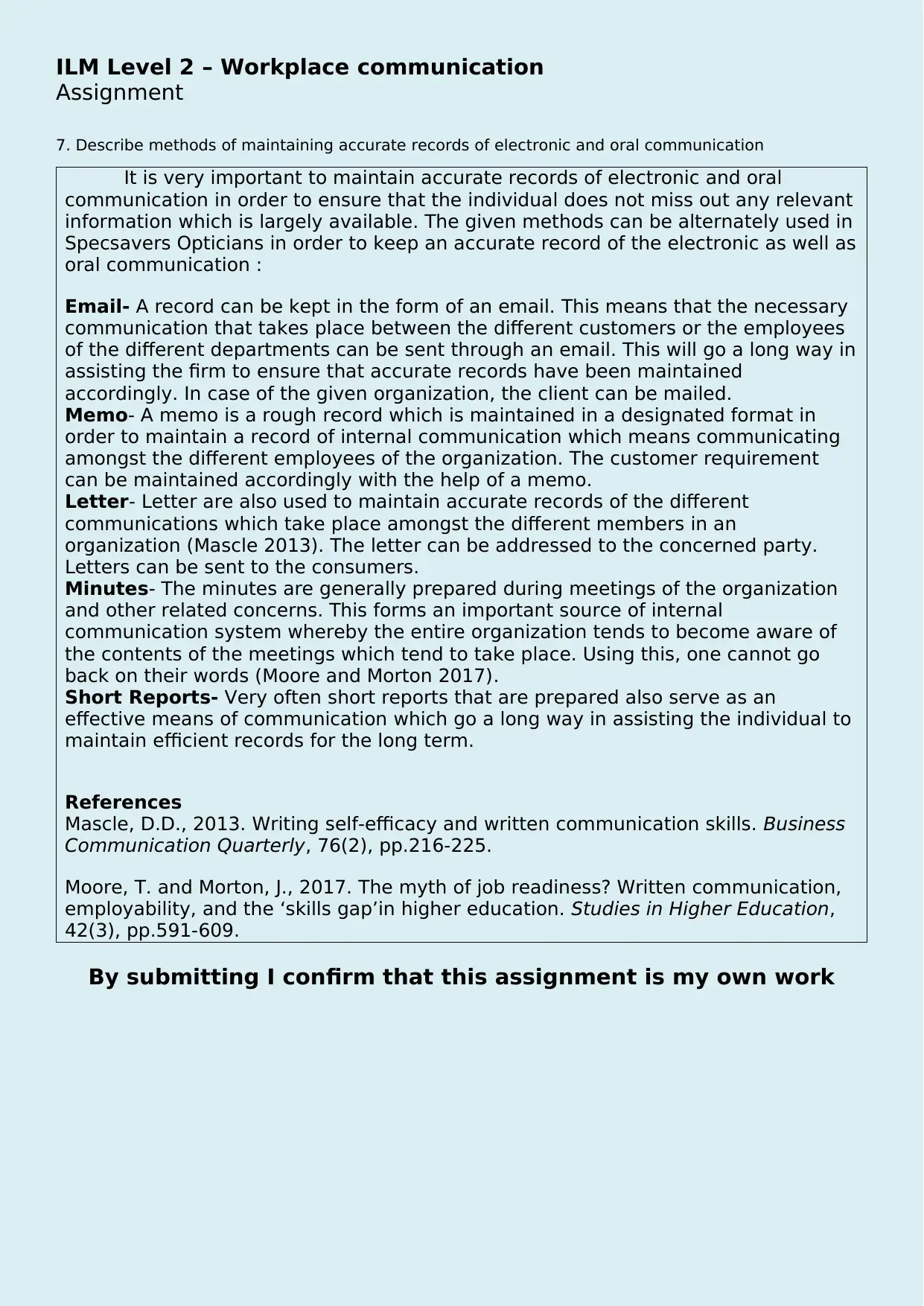
ILM Level 2 – Workplace communication
Assignment
7. Describe methods of maintaining accurate records of electronic and oral communication
It is very important to maintain accurate records of electronic and oral
communication in order to ensure that the individual does not miss out any relevant
information which is largely available. The given methods can be alternately used in
Specsavers Opticians in order to keep an accurate record of the electronic as well as
oral communication :
Email- A record can be kept in the form of an email. This means that the necessary
communication that takes place between the different customers or the employees
of the different departments can be sent through an email. This will go a long way in
assisting the firm to ensure that accurate records have been maintained
accordingly. In case of the given organization, the client can be mailed.
Memo- A memo is a rough record which is maintained in a designated format in
order to maintain a record of internal communication which means communicating
amongst the different employees of the organization. The customer requirement
can be maintained accordingly with the help of a memo.
Letter- Letter are also used to maintain accurate records of the different
communications which take place amongst the different members in an
organization (Mascle 2013). The letter can be addressed to the concerned party.
Letters can be sent to the consumers.
Minutes- The minutes are generally prepared during meetings of the organization
and other related concerns. This forms an important source of internal
communication system whereby the entire organization tends to become aware of
the contents of the meetings which tend to take place. Using this, one cannot go
back on their words (Moore and Morton 2017).
Short Reports- Very often short reports that are prepared also serve as an
effective means of communication which go a long way in assisting the individual to
maintain efficient records for the long term.
References
Mascle, D.D., 2013. Writing self-efficacy and written communication skills. Business
Communication Quarterly, 76(2), pp.216-225.
Moore, T. and Morton, J., 2017. The myth of job readiness? Written communication,
employability, and the ‘skills gap’in higher education. Studies in Higher Education,
42(3), pp.591-609.
By submitting I confirm that this assignment is my own work
Assignment
7. Describe methods of maintaining accurate records of electronic and oral communication
It is very important to maintain accurate records of electronic and oral
communication in order to ensure that the individual does not miss out any relevant
information which is largely available. The given methods can be alternately used in
Specsavers Opticians in order to keep an accurate record of the electronic as well as
oral communication :
Email- A record can be kept in the form of an email. This means that the necessary
communication that takes place between the different customers or the employees
of the different departments can be sent through an email. This will go a long way in
assisting the firm to ensure that accurate records have been maintained
accordingly. In case of the given organization, the client can be mailed.
Memo- A memo is a rough record which is maintained in a designated format in
order to maintain a record of internal communication which means communicating
amongst the different employees of the organization. The customer requirement
can be maintained accordingly with the help of a memo.
Letter- Letter are also used to maintain accurate records of the different
communications which take place amongst the different members in an
organization (Mascle 2013). The letter can be addressed to the concerned party.
Letters can be sent to the consumers.
Minutes- The minutes are generally prepared during meetings of the organization
and other related concerns. This forms an important source of internal
communication system whereby the entire organization tends to become aware of
the contents of the meetings which tend to take place. Using this, one cannot go
back on their words (Moore and Morton 2017).
Short Reports- Very often short reports that are prepared also serve as an
effective means of communication which go a long way in assisting the individual to
maintain efficient records for the long term.
References
Mascle, D.D., 2013. Writing self-efficacy and written communication skills. Business
Communication Quarterly, 76(2), pp.216-225.
Moore, T. and Morton, J., 2017. The myth of job readiness? Written communication,
employability, and the ‘skills gap’in higher education. Studies in Higher Education,
42(3), pp.591-609.
By submitting I confirm that this assignment is my own work
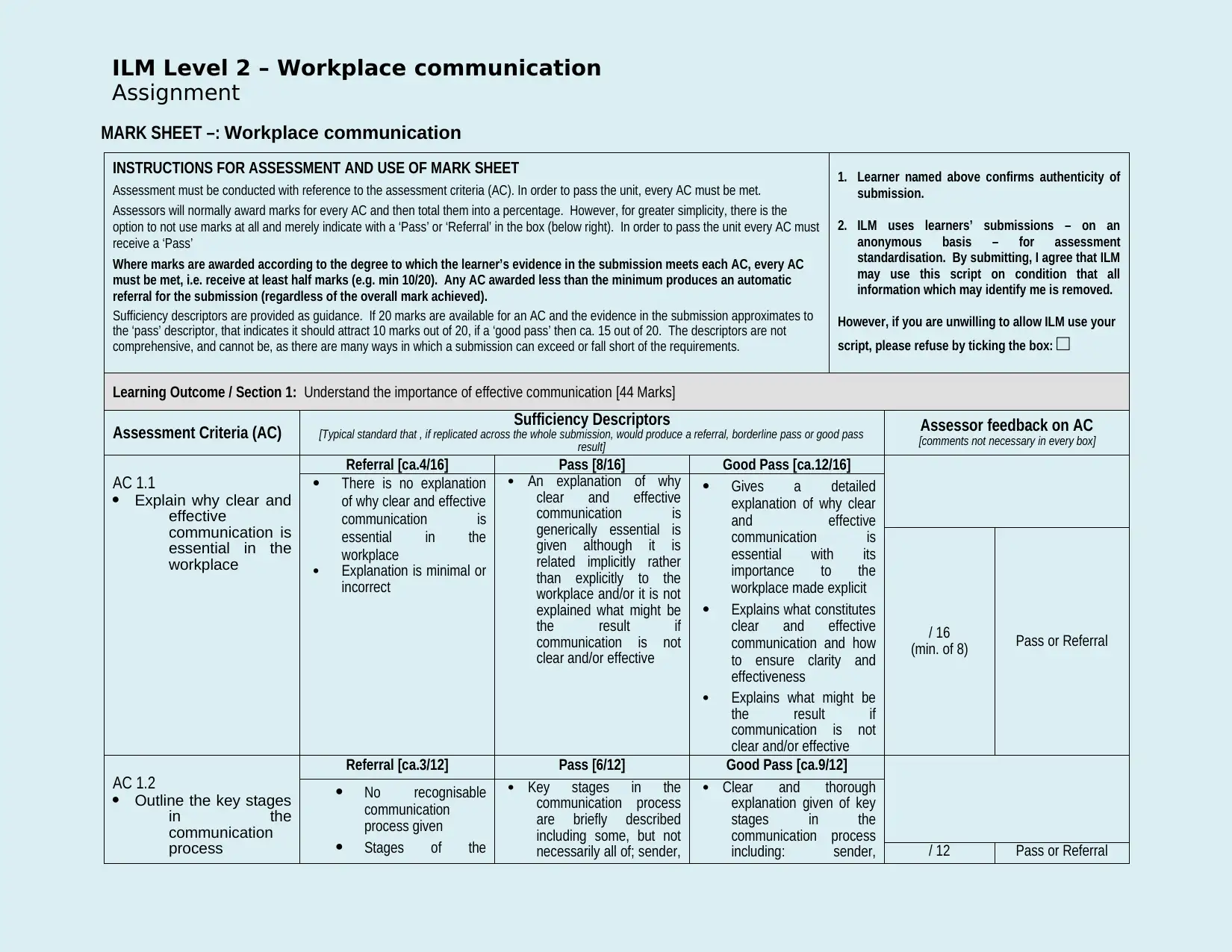
ILM Level 2 – Workplace communication
Assignment
MARK SHEET –: Workplace communication
INSTRUCTIONS FOR ASSESSMENT AND USE OF MARK SHEET
Assessment must be conducted with reference to the assessment criteria (AC). In order to pass the unit, every AC must be met.
Assessors will normally award marks for every AC and then total them into a percentage. However, for greater simplicity, there is the
option to not use marks at all and merely indicate with a ‘Pass’ or ‘Referral’ in the box (below right). In order to pass the unit every AC must
receive a ‘Pass’
Where marks are awarded according to the degree to which the learner’s evidence in the submission meets each AC, every AC
must be met, i.e. receive at least half marks (e.g. min 10/20). Any AC awarded less than the minimum produces an automatic
referral for the submission (regardless of the overall mark achieved).
Sufficiency descriptors are provided as guidance. If 20 marks are available for an AC and the evidence in the submission approximates to
the ‘pass’ descriptor, that indicates it should attract 10 marks out of 20, if a ‘good pass’ then ca. 15 out of 20. The descriptors are not
comprehensive, and cannot be, as there are many ways in which a submission can exceed or fall short of the requirements.
1. Learner named above confirms authenticity of
submission.
2. ILM uses learners’ submissions – on an
anonymous basis – for assessment
standardisation. By submitting, I agree that ILM
may use this script on condition that all
information which may identify me is removed.
However, if you are unwilling to allow ILM use your
script, please refuse by ticking the box: □
Learning Outcome / Section 1: Understand the importance of effective communication [44 Marks]
Assessment Criteria (AC) Sufficiency Descriptors
[Typical standard that , if replicated across the whole submission, would produce a referral, borderline pass or good pass
result]
Assessor feedback on AC
[comments not necessary in every box]
AC 1.1
Explain why clear and
effective
communication is
essential in the
workplace
Referral [ca.4/16] Pass [8/16] Good Pass [ca.12/16]
There is no explanation
of why clear and effective
communication is
essential in the
workplace
Explanation is minimal or
incorrect
An explanation of why
clear and effective
communication is
generically essential is
given although it is
related implicitly rather
than explicitly to the
workplace and/or it is not
explained what might be
the result if
communication is not
clear and/or effective
Gives a detailed
explanation of why clear
and effective
communication is
essential with its
importance to the
workplace made explicit
Explains what constitutes
clear and effective
communication and how
to ensure clarity and
effectiveness
Explains what might be
the result if
communication is not
clear and/or effective
/ 16
(min. of 8) Pass or Referral
AC 1.2
Outline the key stages
in the
communication
process
Referral [ca.3/12] Pass [6/12] Good Pass [ca.9/12]
No recognisable
communication
process given
Stages of the
Key stages in the
communication process
are briefly described
including some, but not
necessarily all of; sender,
Clear and thorough
explanation given of key
stages in the
communication process
including: sender, / 12 Pass or Referral
Assignment
MARK SHEET –: Workplace communication
INSTRUCTIONS FOR ASSESSMENT AND USE OF MARK SHEET
Assessment must be conducted with reference to the assessment criteria (AC). In order to pass the unit, every AC must be met.
Assessors will normally award marks for every AC and then total them into a percentage. However, for greater simplicity, there is the
option to not use marks at all and merely indicate with a ‘Pass’ or ‘Referral’ in the box (below right). In order to pass the unit every AC must
receive a ‘Pass’
Where marks are awarded according to the degree to which the learner’s evidence in the submission meets each AC, every AC
must be met, i.e. receive at least half marks (e.g. min 10/20). Any AC awarded less than the minimum produces an automatic
referral for the submission (regardless of the overall mark achieved).
Sufficiency descriptors are provided as guidance. If 20 marks are available for an AC and the evidence in the submission approximates to
the ‘pass’ descriptor, that indicates it should attract 10 marks out of 20, if a ‘good pass’ then ca. 15 out of 20. The descriptors are not
comprehensive, and cannot be, as there are many ways in which a submission can exceed or fall short of the requirements.
1. Learner named above confirms authenticity of
submission.
2. ILM uses learners’ submissions – on an
anonymous basis – for assessment
standardisation. By submitting, I agree that ILM
may use this script on condition that all
information which may identify me is removed.
However, if you are unwilling to allow ILM use your
script, please refuse by ticking the box: □
Learning Outcome / Section 1: Understand the importance of effective communication [44 Marks]
Assessment Criteria (AC) Sufficiency Descriptors
[Typical standard that , if replicated across the whole submission, would produce a referral, borderline pass or good pass
result]
Assessor feedback on AC
[comments not necessary in every box]
AC 1.1
Explain why clear and
effective
communication is
essential in the
workplace
Referral [ca.4/16] Pass [8/16] Good Pass [ca.12/16]
There is no explanation
of why clear and effective
communication is
essential in the
workplace
Explanation is minimal or
incorrect
An explanation of why
clear and effective
communication is
generically essential is
given although it is
related implicitly rather
than explicitly to the
workplace and/or it is not
explained what might be
the result if
communication is not
clear and/or effective
Gives a detailed
explanation of why clear
and effective
communication is
essential with its
importance to the
workplace made explicit
Explains what constitutes
clear and effective
communication and how
to ensure clarity and
effectiveness
Explains what might be
the result if
communication is not
clear and/or effective
/ 16
(min. of 8) Pass or Referral
AC 1.2
Outline the key stages
in the
communication
process
Referral [ca.3/12] Pass [6/12] Good Pass [ca.9/12]
No recognisable
communication
process given
Stages of the
Key stages in the
communication process
are briefly described
including some, but not
necessarily all of; sender,
Clear and thorough
explanation given of key
stages in the
communication process
including: sender, / 12 Pass or Referral
⊘ This is a preview!⊘
Do you want full access?
Subscribe today to unlock all pages.

Trusted by 1+ million students worldwide
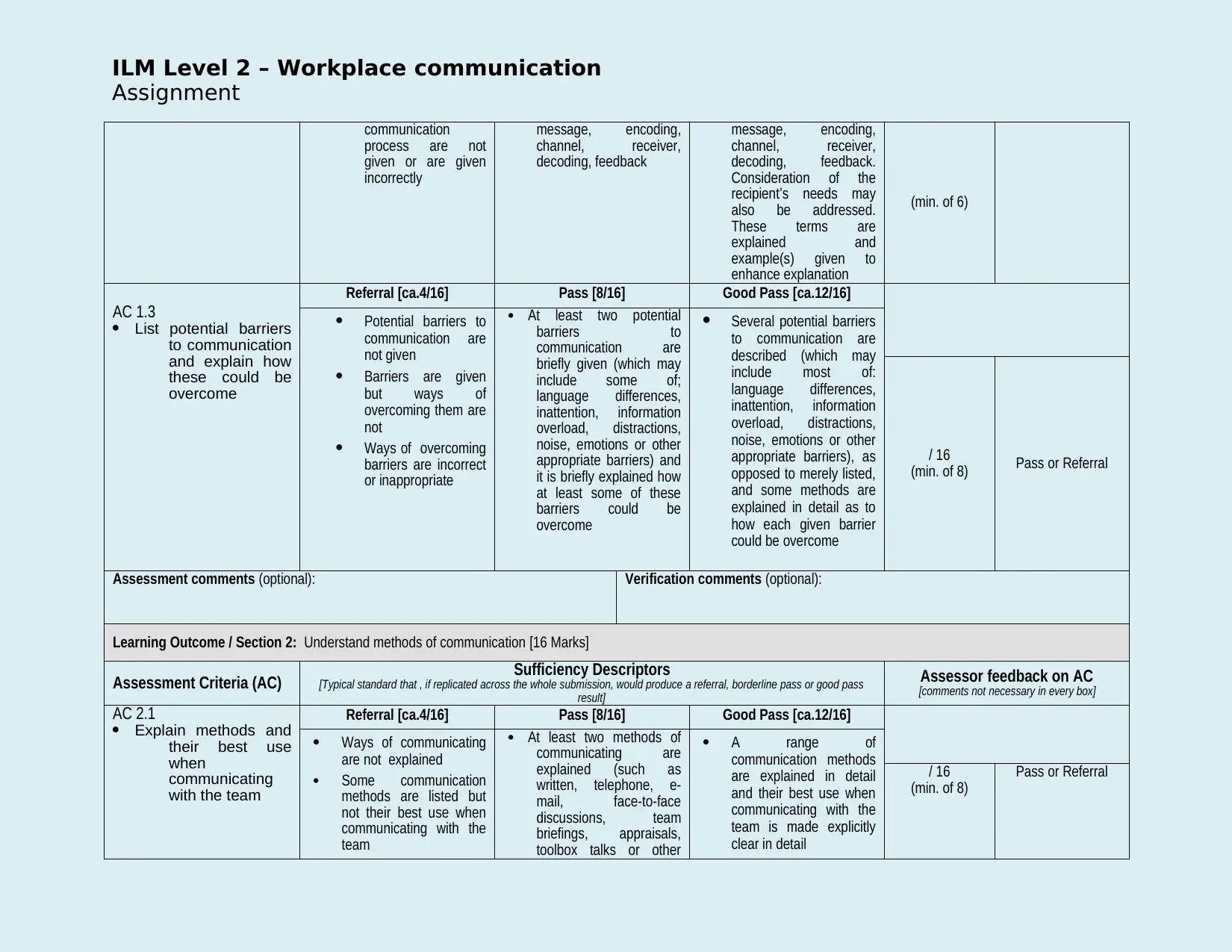
ILM Level 2 – Workplace communication
Assignment
communication
process are not
given or are given
incorrectly
message, encoding,
channel, receiver,
decoding, feedback
message, encoding,
channel, receiver,
decoding, feedback.
Consideration of the
recipient’s needs may
also be addressed.
These terms are
explained and
example(s) given to
enhance explanation
(min. of 6)
AC 1.3
List potential barriers
to communication
and explain how
these could be
overcome
Referral [ca.4/16] Pass [8/16] Good Pass [ca.12/16]
Potential barriers to
communication are
not given
Barriers are given
but ways of
overcoming them are
not
Ways of overcoming
barriers are incorrect
or inappropriate
At least two potential
barriers to
communication are
briefly given (which may
include some of;
language differences,
inattention, information
overload, distractions,
noise, emotions or other
appropriate barriers) and
it is briefly explained how
at least some of these
barriers could be
overcome
Several potential barriers
to communication are
described (which may
include most of:
language differences,
inattention, information
overload, distractions,
noise, emotions or other
appropriate barriers), as
opposed to merely listed,
and some methods are
explained in detail as to
how each given barrier
could be overcome
/ 16
(min. of 8) Pass or Referral
Assessment comments (optional): Verification comments (optional):
Learning Outcome / Section 2: Understand methods of communication [16 Marks]
Assessment Criteria (AC) Sufficiency Descriptors
[Typical standard that , if replicated across the whole submission, would produce a referral, borderline pass or good pass
result]
Assessor feedback on AC
[comments not necessary in every box]
AC 2.1
Explain methods and
their best use
when
communicating
with the team
Referral [ca.4/16] Pass [8/16] Good Pass [ca.12/16]
Ways of communicating
are not explained
Some communication
methods are listed but
not their best use when
communicating with the
team
At least two methods of
communicating are
explained (such as
written, telephone, e-
mail, face-to-face
discussions, team
briefings, appraisals,
toolbox talks or other
A range of
communication methods
are explained in detail
and their best use when
communicating with the
team is made explicitly
clear in detail
/ 16
(min. of 8)
Pass or Referral
Assignment
communication
process are not
given or are given
incorrectly
message, encoding,
channel, receiver,
decoding, feedback
message, encoding,
channel, receiver,
decoding, feedback.
Consideration of the
recipient’s needs may
also be addressed.
These terms are
explained and
example(s) given to
enhance explanation
(min. of 6)
AC 1.3
List potential barriers
to communication
and explain how
these could be
overcome
Referral [ca.4/16] Pass [8/16] Good Pass [ca.12/16]
Potential barriers to
communication are
not given
Barriers are given
but ways of
overcoming them are
not
Ways of overcoming
barriers are incorrect
or inappropriate
At least two potential
barriers to
communication are
briefly given (which may
include some of;
language differences,
inattention, information
overload, distractions,
noise, emotions or other
appropriate barriers) and
it is briefly explained how
at least some of these
barriers could be
overcome
Several potential barriers
to communication are
described (which may
include most of:
language differences,
inattention, information
overload, distractions,
noise, emotions or other
appropriate barriers), as
opposed to merely listed,
and some methods are
explained in detail as to
how each given barrier
could be overcome
/ 16
(min. of 8) Pass or Referral
Assessment comments (optional): Verification comments (optional):
Learning Outcome / Section 2: Understand methods of communication [16 Marks]
Assessment Criteria (AC) Sufficiency Descriptors
[Typical standard that , if replicated across the whole submission, would produce a referral, borderline pass or good pass
result]
Assessor feedback on AC
[comments not necessary in every box]
AC 2.1
Explain methods and
their best use
when
communicating
with the team
Referral [ca.4/16] Pass [8/16] Good Pass [ca.12/16]
Ways of communicating
are not explained
Some communication
methods are listed but
not their best use when
communicating with the
team
At least two methods of
communicating are
explained (such as
written, telephone, e-
mail, face-to-face
discussions, team
briefings, appraisals,
toolbox talks or other
A range of
communication methods
are explained in detail
and their best use when
communicating with the
team is made explicitly
clear in detail
/ 16
(min. of 8)
Pass or Referral
Paraphrase This Document
Need a fresh take? Get an instant paraphrase of this document with our AI Paraphraser
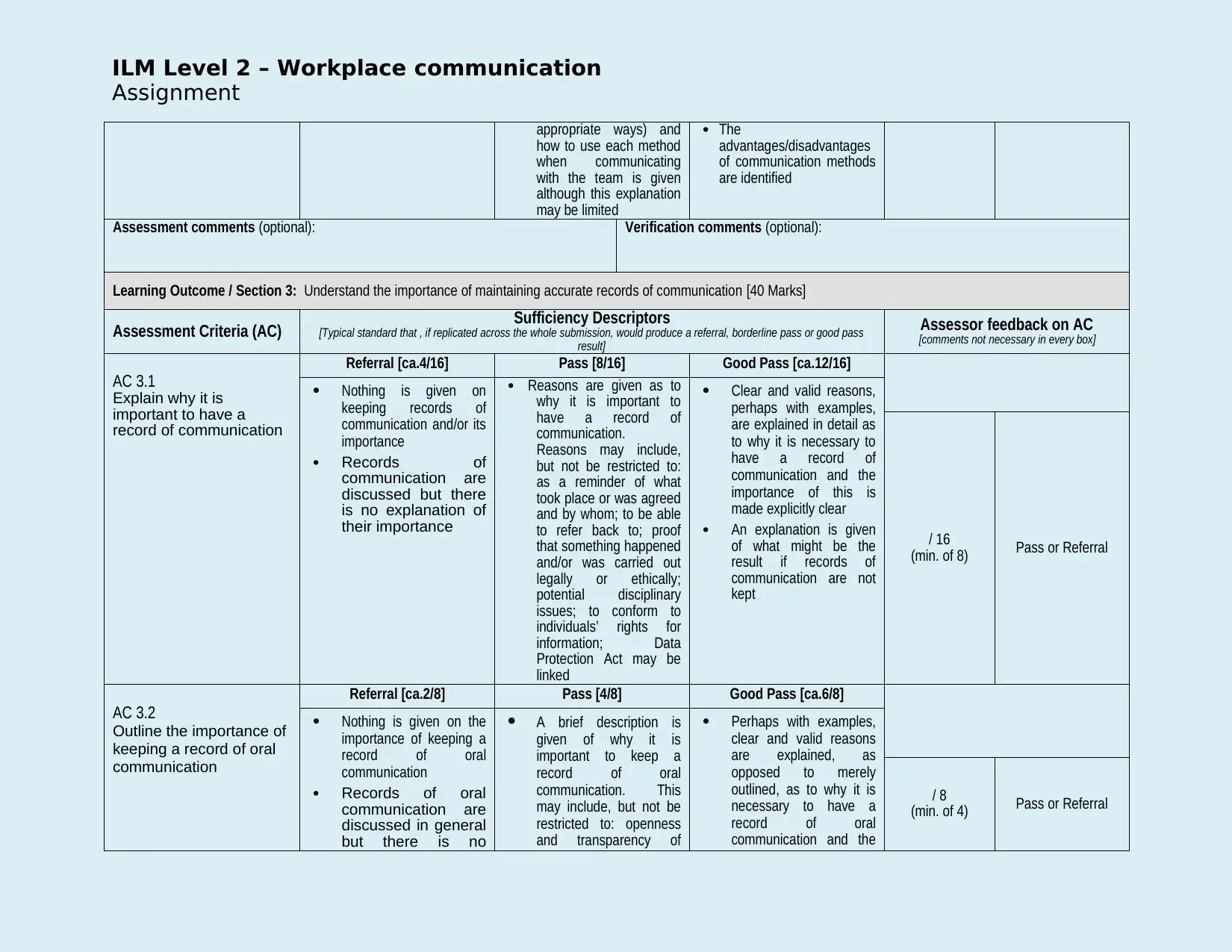
ILM Level 2 – Workplace communication
Assignment
appropriate ways) and
how to use each method
when communicating
with the team is given
although this explanation
may be limited
The
advantages/disadvantages
of communication methods
are identified
Assessment comments (optional): Verification comments (optional):
Learning Outcome / Section 3: Understand the importance of maintaining accurate records of communication [40 Marks]
Assessment Criteria (AC) Sufficiency Descriptors
[Typical standard that , if replicated across the whole submission, would produce a referral, borderline pass or good pass
result]
Assessor feedback on AC
[comments not necessary in every box]
AC 3.1
Explain why it is
important to have a
record of communication
Referral [ca.4/16] Pass [8/16] Good Pass [ca.12/16]
Nothing is given on
keeping records of
communication and/or its
importance
Records of
communication are
discussed but there
is no explanation of
their importance
Reasons are given as to
why it is important to
have a record of
communication.
Reasons may include,
but not be restricted to:
as a reminder of what
took place or was agreed
and by whom; to be able
to refer back to; proof
that something happened
and/or was carried out
legally or ethically;
potential disciplinary
issues; to conform to
individuals’ rights for
information; Data
Protection Act may be
linked
Clear and valid reasons,
perhaps with examples,
are explained in detail as
to why it is necessary to
have a record of
communication and the
importance of this is
made explicitly clear
An explanation is given
of what might be the
result if records of
communication are not
kept
/ 16
(min. of 8) Pass or Referral
AC 3.2
Outline the importance of
keeping a record of oral
communication
Referral [ca.2/8] Pass [4/8] Good Pass [ca.6/8]
Nothing is given on the
importance of keeping a
record of oral
communication
Records of oral
communication are
discussed in general
but there is no
A brief description is
given of why it is
important to keep a
record of oral
communication. This
may include, but not be
restricted to: openness
and transparency of
Perhaps with examples,
clear and valid reasons
are explained, as
opposed to merely
outlined, as to why it is
necessary to have a
record of oral
communication and the
/ 8
(min. of 4) Pass or Referral
Assignment
appropriate ways) and
how to use each method
when communicating
with the team is given
although this explanation
may be limited
The
advantages/disadvantages
of communication methods
are identified
Assessment comments (optional): Verification comments (optional):
Learning Outcome / Section 3: Understand the importance of maintaining accurate records of communication [40 Marks]
Assessment Criteria (AC) Sufficiency Descriptors
[Typical standard that , if replicated across the whole submission, would produce a referral, borderline pass or good pass
result]
Assessor feedback on AC
[comments not necessary in every box]
AC 3.1
Explain why it is
important to have a
record of communication
Referral [ca.4/16] Pass [8/16] Good Pass [ca.12/16]
Nothing is given on
keeping records of
communication and/or its
importance
Records of
communication are
discussed but there
is no explanation of
their importance
Reasons are given as to
why it is important to
have a record of
communication.
Reasons may include,
but not be restricted to:
as a reminder of what
took place or was agreed
and by whom; to be able
to refer back to; proof
that something happened
and/or was carried out
legally or ethically;
potential disciplinary
issues; to conform to
individuals’ rights for
information; Data
Protection Act may be
linked
Clear and valid reasons,
perhaps with examples,
are explained in detail as
to why it is necessary to
have a record of
communication and the
importance of this is
made explicitly clear
An explanation is given
of what might be the
result if records of
communication are not
kept
/ 16
(min. of 8) Pass or Referral
AC 3.2
Outline the importance of
keeping a record of oral
communication
Referral [ca.2/8] Pass [4/8] Good Pass [ca.6/8]
Nothing is given on the
importance of keeping a
record of oral
communication
Records of oral
communication are
discussed in general
but there is no
A brief description is
given of why it is
important to keep a
record of oral
communication. This
may include, but not be
restricted to: openness
and transparency of
Perhaps with examples,
clear and valid reasons
are explained, as
opposed to merely
outlined, as to why it is
necessary to have a
record of oral
communication and the
/ 8
(min. of 4) Pass or Referral

ILM Level 2 – Workplace communication
Assignment
mention of their
importance interactions; as a factual
reminder of what took
place or was agreed; as
proof that something did
take place and/or was
carried out legally or
ethically; potential
disciplinary issues; to
conform to individuals’
rights for information;
Data Protection Act may
be linked
importance of this is
made explicitly clear
Outlines what might be
the result if records of
communication are not
kept
AC 3.3
Describe methods of
maintaining accurate
records of electronic and
oral communication
Referral [ca.4/16] Pass [8/16] Good Pass [ca.12/16]
No ways of maintaining
accurate records of
electronic and oral
communication are given
Ways of maintaining
accurate records of
electronic and oral
communication are
merely listed and no
description is given or, if
described, are incorrect
or inappropriate for
maintaining accurate
records
At least two ways of
maintaining accurate
records of electronic and
oral communication are
given although the
description may be
limited. The methods
should enable some
monitoring of accuracy of
records
A variety of methods of
maintaining accurate
records of electronic and
oral communication are
fully described and
perhaps explained.
Some of the methods
may be documented or
paper based whilst
others are electronic.
Examples of each may
be given.
/ 16
(min. of 8) Pass or Referral
Section comments (optional): Verification comments (optional):
/ 100 TOTALMARKS
Assessor’s Decision Quality Assurance Use
Outcome (delete as applicable):
PASS / REFERRAL
Signature of Assessor:
Date:
Outcome (delete as applicable):
PASS / REFERRAL
Signature of QA:
Date of QA check:
Assignment
mention of their
importance interactions; as a factual
reminder of what took
place or was agreed; as
proof that something did
take place and/or was
carried out legally or
ethically; potential
disciplinary issues; to
conform to individuals’
rights for information;
Data Protection Act may
be linked
importance of this is
made explicitly clear
Outlines what might be
the result if records of
communication are not
kept
AC 3.3
Describe methods of
maintaining accurate
records of electronic and
oral communication
Referral [ca.4/16] Pass [8/16] Good Pass [ca.12/16]
No ways of maintaining
accurate records of
electronic and oral
communication are given
Ways of maintaining
accurate records of
electronic and oral
communication are
merely listed and no
description is given or, if
described, are incorrect
or inappropriate for
maintaining accurate
records
At least two ways of
maintaining accurate
records of electronic and
oral communication are
given although the
description may be
limited. The methods
should enable some
monitoring of accuracy of
records
A variety of methods of
maintaining accurate
records of electronic and
oral communication are
fully described and
perhaps explained.
Some of the methods
may be documented or
paper based whilst
others are electronic.
Examples of each may
be given.
/ 16
(min. of 8) Pass or Referral
Section comments (optional): Verification comments (optional):
/ 100 TOTALMARKS
Assessor’s Decision Quality Assurance Use
Outcome (delete as applicable):
PASS / REFERRAL
Signature of Assessor:
Date:
Outcome (delete as applicable):
PASS / REFERRAL
Signature of QA:
Date of QA check:
⊘ This is a preview!⊘
Do you want full access?
Subscribe today to unlock all pages.

Trusted by 1+ million students worldwide
1 out of 6
Your All-in-One AI-Powered Toolkit for Academic Success.
+13062052269
info@desklib.com
Available 24*7 on WhatsApp / Email
![[object Object]](/_next/static/media/star-bottom.7253800d.svg)
Unlock your academic potential
Copyright © 2020–2025 A2Z Services. All Rights Reserved. Developed and managed by ZUCOL.